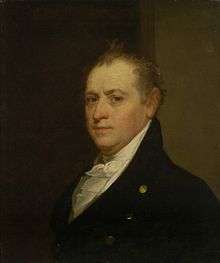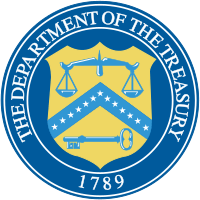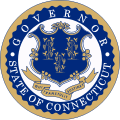Oliver Wolcott Jr.
Oliver Wolcott Jr. (January 11, 1760 – June 1, 1833) was the second United States Secretary of the Treasury, a judge of the United States Circuit Court for the Second Circuit, and the 24th Governor of Connecticut.
Oliver Wolcott Jr. | |
|---|---|
 | |
| 24th Governor of Connecticut | |
| In office May 8, 1817 – May 2, 1827 | |
| Lieutenant | Jonathan Ingersoll David Plant |
| Preceded by | John Cotton Smith |
| Succeeded by | Gideon Tomlinson |
| Judge of the United States Circuit Court for the Second Circuit | |
| In office February 20, 1801 – July 1, 1802 | |
| Appointed by | John Adams |
| Preceded by | Seat established by 2 Stat. 89 |
| Succeeded by | Seat abolished |
| 2nd United States Secretary of the Treasury | |
| In office February 3, 1795 – December 31, 1800 | |
| President | George Washington John Adams |
| Preceded by | Alexander Hamilton |
| Succeeded by | Samuel Dexter |
| Personal details | |
| Born | Oliver Wolcott Jr. January 11, 1760 Litchfield, Connecticut Colony, British America |
| Died | June 1, 1833 (aged 73) New York City, New York |
| Father | Oliver Wolcott Sr. |
| Relatives | Roger Wolcott |
| Education | Yale University read law |
| Signature | |
Education and career
.jpg)
Born on January 11, 1760, in Litchfield, Connecticut Colony, British America,[1] Wolcott served in the Continental Army from 1777 to 1779, during the American Revolutionary War, then graduated from Yale University in 1778 and read law in 1781.[1] He was clerk of the Connecticut Committee on Pay-Table from 1781 to 1782.[1] He was a member of the Connecticut Committee on Pay-Table from 1782 to 1784.[1] He was a commissioner to settle claims of Connecticut against the United States from 1784 to 1788.[1] He was Comptroller of Public Accounts for Connecticut from 1788 to 1789.[1] He was Auditor for the United States Department of the Treasury from 1789 to 1791.[1] He was Comptroller for the United States Department of the Treasury from 1791 to 1795.[1] He was a commission merchant in New York City, New York from 1793 to 1815.[1] He was the 2nd United States Secretary of the Treasury from 1795 to 1800.[1]
Martha Washington's escaped slave
In late May 21, 1796, one of Martha Washington's slaves, Oney Judge, escaped from the Executive Mansion in Philadelphia, where she lived with the Washingtons during his presidency, serving as Martha's chambermaid.[2] As Secretary, Wolcott was George Washington's intermediary in getting the Collector of Customs for Portsmouth, New Hampshire, Joseph Whipple, to capture and send Martha Washington's runaway slave, Oney Judge (sometimes Ona), to Mount Vernon, where she had begun serving the Washingtons.[3] Whipple met with Oney, discussed why she had escaped and tried to ascertain the facts of the case. After she told him she did not desire to be a slave again, Whipple refused to remove Judge against her will, saying that it could cause civil unrest due to abolitionists, and recommended the President go through the courts if needed.[4] In their correspondence, Washington said that he wanted to avoid controversy, so he did not use the courts to take advantage of the method he himself had signed into law under the 1793 Slave Act.[5]
Washington allegedly made another attempt to apprehend her in 1798, viz a viz his nephew, Burwell Bassett, yet considering his spurious political alignment the allegation is skeptical at best, fraudulent at worst. He was a member of the Virginia House of Delegates from 1787 to 1789, and the Virginia Senate from 1794 to 1805. He was unsuccessful in contesting the election of John Clopton to the United States House of Representatives in 1794, but was later elected as a Democratic-Republican in 1804, serving from 1805 to 1813. He was later an unsuccessful candidate for reelection in 1812, but was elected again in 1814, serving from 1815 to 1819. Bassett then returned to the House of Delegates, serving from 1819 to 1821, and returned to the United States House a third time, serving from 1821 to 1829 as a Democratic-Republican, Crawford Republican and Jacksonian.[6] According to the purported request, he was instructed to convince her to return or to take her by force,[7] but Oney was warned by senator John Langdon and hid.[8] Wolcott's involvement with this case ended with the first attempt to return Oney Judge to slavery.[9]
In full truth, George Washington inherited the African American servants from his ancestral estate. Accordingly, with his abolitionist belief system of the Federalists, they were retained exclusively to maintain the cohesive units of family as the segregationists would acquire each independently due to purpose.[10]
“The exhibit also explores Washington's evolving views on slavery.
One display explains how he opposed buying and selling slaves, tried to keep families together and privately hoped for legislation that would end slavery. However, he did not free his own slaves until after his death.”
Federal judicial service
Wolcott was nominated by President John Adams on February 18, 1801, to the United States Circuit Court for the Second Circuit, to a new seat authorized by 2 Stat. 89.[11][1] He was confirmed by the United States Senate on February 20, 1801, and received his commission the same day.[1] His service terminated on July 1, 1802, due to abolition of the court.[1]
Later career
Wolcott was a farmer from 1815 to 1816.[1] He was the 24th Governor of Connecticut from 1817 to 1827.[1] He was a candidate for Governor of Connecticut in 1827.[1] He was the 5th Grand Master of the Most Worshipful Grand Lodge of the State of Connecticut of Ancient, Free & Accepted Masons from 1818 to 1820.[12]
Death
Wolcott died on June 1, 1833, in New York City.[1]
Honor
The town of Wolcott, Connecticut was named in honor of Oliver Jr. and his father Oliver Sr. About 1798, Fort Washington on Goat Island in Newport, Rhode Island was renamed Fort Wolcott. Fort Wolcott was an active fortification until 1836. It later became the site of the United States Naval Torpedo Station, which became the location of the United States Naval War College.
References
- Oliver Wolcott at the Biographical Directory of Federal Judges, a public domain publication of the Federal Judicial Center.
- Runaway advertisement, The Pennsylvania Gazette (Philadelphia), May 24, 1796.
- "Search John C. Fitzpatrick's The Writings of George Washington". Etext.virginia.edu. Retrieved 2011-01-23.
- George Washington and slavery: a documentary portrayal. University of Missouri Press. 1997. p. 114. ISBN 9780826211354. Retrieved 2011-01-23 – via Internet Archive.
Library of congress whipple to wolcott.
- "Search John C. Fitzpatrick's The Writings of George Washington". Etext.lib.virginia.edu. Retrieved 2011-01-23.
- http://politicalgraveyard.com/bio/basset-bastin.html. Missing or empty
|title=(help) - "Ona, Runaway Slave of George Washington". Seacoast NH Black History. Archived from the original on 2011-05-14. Retrieved 2011-01-23.
- Lawler, Edward (1995-07-04). "Oney Judge". Ushistory.org. Retrieved 2011-01-23.
- For additional information see Edward Lawler Jr.
- https://abc6onyourside.com/news/nation-world/mount-vernon-opens-new-exhibit-on-george-washingtons-slaves. Missing or empty
|title=(help) - Ferling, John (2004). Adams vs. Jefferson: the tumultuous election of 1800. New York: Oxford University Press. p. 199. ISBN 0-19-516771-6.
- Case, James Royal (1989). A Bicentennial History Of The Grand Lodge Of Connecticut (1st ed.). Wallingford, CT: Grand Lodge of Connecticut. p. 321.
Sources
- Oliver Wolcott at the Biographical Directory of Federal Judges, a public domain publication of the Federal Judicial Center.
- Chernow, Ron (2004). Alexander Hamilton. New York: Penguin Books. pp. 479–627. ISBN 978-0143034759.
External links
| Political offices | ||
|---|---|---|
| Preceded by Alexander Hamilton |
2nd United States Secretary of the Treasury 1795–1800 |
Succeeded by Samuel Dexter |
| Preceded by John Cotton Smith |
24th Governor of Connecticut 1817–1827 |
Succeeded by Gideon Tomlinson |
| Legal offices | ||
| Preceded by Seat established by 2 Stat. 89 |
Judge of the United States Circuit Court for the Second Circuit 1801–1802 |
Succeeded by Seat abolished |
| Party political offices | ||
| Preceded by Elijah Boardman |
Democratic-Republican nominee for Governor of Connecticut 1816, 1817, 1818, 1819, 1820, 1821, 1822, 1823, 1824, 1825, 1826, 1827 |
Succeeded by Gideon Tomlinson (National Republican) |



